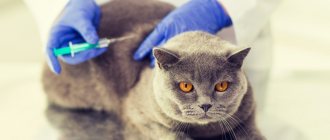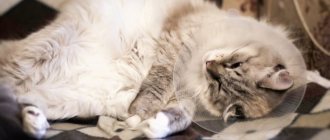When it comes to cat ovariohysterectomy, not everyone knows what it is and how it is done. This term refers to the removal of the uterus and ovaries. There are different surgical techniques. They differ in the size of the wound surface, the location of the incision and the method of removing the internal reproductive organs.
It is popularly believed that cats (females) are sterilized, and cats (males) are castrated. However, this is not quite true. Sterilization refers to the removal of only the ovaries. The uterus remains in the abdominal cavity, although it does not perform any functions. This operation is called oophorectomy. During an ovariohysterectomy, all internal genital organs are removed. This type of surgery is called castration of females.
Types of operations
Depending on what is removed during surgery, sterilization is divided into two types.
In the first case, only the ovaries are removed; this operation is called oophorectomy. If the cat has never given birth and is young and healthy, then spaying will be sufficient.
However, veterinarians recommend removing the uterus in order to avoid infections and cancer in it in the future. Surgery to remove the ovaries and uterus is called an ovariohysterectomy.
Reference!
It is recommended to carry out sterilization (castration) surgery before the first heat.
There is also such a method as tubal occlusion - pulling the fallopian tubes. This procedure helps prevent conception without changing hormonal levels. After this operation, there remains a risk of certain problems associated with the reproductive system.
Ovariectomy
Ovariectomy involves removal of the ovaries. After spaying, cats become more balanced as their hormonal levels change. Due to the absence of glands responsible for the release of sex hormones, estrus disappears. The disadvantage of this type of sterilization is that it can only be carried out at an early age before the first heat.
Ovariohysterectomy
Ovariohysterectomy – involves the removal of the ovaries and uterus. Many veterinarians agree that this option is the most acceptable, because... solves the problem 100%.
Differences between castration and sterilization
Speaking about the difference between the concepts of sterilization and castration, we are accustomed to calling sterilization an operation performed on a cat, and castration - an operation performed on a cat. In fact, when talking about different types of sterilization, we make a mistake.
Sterilization involves ligating the fallopian tubes (for cats) or the vas deferens (for cats). In this case, only the reproductive function stops, but the sexual desire remains.
Castration is the surgical removal of the testicles or ovaries and uterus of an animal. Castration, unlike sterilization, not only deprives the animal of the function of procreation, but also removes the feeling of sexual desire. That is why castration is recommended to completely solve the problem.
Indications for ovariohysterectomy
At 7-9 months, kittens become sexually mature. Cats begin their first heat. During this period, the pet screams loudly, may mark its territory, refuses to eat, and behaves restlessly. This happens due to the inability to satisfy the sexual instinct. This causes inconvenience not only to the cat itself, but also to its owners. Castration or sterilization will help avoid such problems.
Veterinarians advise removing the ovaries along with the uterus. With oophorectomy (removal of only the ovaries), sexual activity disappears, but the risk of developing cancer pathologies of the uterus remains.
Ovariohysterectomy in cats has the following indications:
- mammary gland hyperplasia;
- prevention of unwanted pregnancy;
- getting rid of unwanted pregnancy;
- ovarian cysts causing symmetrical alopecia;
- tumors of the uterus or ovaries;
- inflammatory processes in the reproductive organs;
- excessive sexual desire.
Castration of cats is carried out to prevent diseases of the uterus. This cannot be achieved through sterilization. Ovariohysterectomy reduces the risk of breast cancer by 7 times.
Cat owners should understand that there is nothing scary about the operation. It does not harm the pet. Castration promotes the psychological and physical calm of the animal and protects against sexually transmitted diseases. Ovariohysterectomy provides the cat with a healthy and long life.
Types of operational access
Before considering the types of sutures, let's talk about what types of surgical access, i.e. choice of puncture site and access to the abdominal cavity exist. The following types of operational access are known:
The linea alba is the most common. The incision is made along the midline of the abdomen. First, the skin is incised, then the tendon of the abdominal muscles, and then the peritoneum.
Along the side line. The incision on the side is 1-3 cm in the area of the lumbar vertebrae.
Laparoscopy is one of the most modern types of operations. The operation is performed both along the white line of the abdomen and on the side. Veterinarians agree that this is a minimally traumatic method. Again, both the uterus and ovaries are removed. In addition to solving the problem of sterilization, during the operation the veterinarian also has the opportunity to examine a number of the cat’s internal organs.
Contraindications to laparoscopic sterilization are diseases of the uterus, large cysts and ovarian tumors, pregnancy, severe adhesions in the abdominal cavity, diaphragmatic hernia, trauma to the diaphragm, obesity.
If there are contraindications, sterilization is performed along the white line of the abdomen.
There is also an option through an ultra-small incision: an incision is made, after which a small surgical hook is inserted, the ligament is lifted, and then the ovary is removed. After suturing, only the ovary and some part of the ligament are removed. In some cases, the uterus is also completely stretched out and removed.
Are there complications?
After surgery, the following postoperative consequences may be observed:
- damage to the urethra;
- development of bleeding;
- the occurrence of fistulas;
- inflammation of the remaining part of the uterus;
- urinary incontinence;
- weight gain.
In addition to the complications described above, the technique itself of performing ovariohysterectomy in a cat can cause complications. They include hematoma of the peritoneal wall and the occurrence of a hernia. The possibility of sutures coming apart, infection in them during or after surgery, and the cat’s individual reaction to the suture material cannot be ruled out. If a few days after surgery the animal behaves in an unusual way, it should be seen by a veterinarian.
Types of seams
In order to connect the cut tissues after surgery, special threads and suturing techniques are used after the cat is sterilized.
As for threads, there are two groups:
- Absorbable - these are usually used for internal sutures.
- Non-absorbable ones are an order of magnitude stronger than the previous ones. If the doctor has decided to use them internally, then they are additionally covered with a capsule.
When sterilizing a cat, there are the following types of sutures:
- Sutures that are placed on the peritoneum and abdominal muscles are usually called internal. They are not removed.
- External ones do not dissolve and require removal of the threads after 10-12 days.
- A cosmetic stitch involves the use of self-dissolving threads and does not require further processing or removal. Accordingly, a cosmetic suture is preferable when sterilizing cats. A cosmetic suture is used during laparoscopy.
Caring for your cat after laparoscopy:
Despite the ease of this manipulation, it is still an operation under anesthesia. Therefore, your tailed pet will need a gentle regime. Immediately after recovery from anesthesia, monitoring of the animal's breathing and temperature is required.
The cat is not allowed to lick the puncture sites, scratch them with its claws (it is better to trim them in advance), or make sudden movements. The animal should not be forced to eat or drink after surgery.
Your doctor will give you all the necessary recommendations, if followed, your kitty will quickly recover and return to an active lifestyle.
Is it necessary to remove the uterus?
Previously, the issue of removing the uterus during sterilization was raised. Still, is it necessary to cut out the uterus? The answer is rather positive.
It is better to remove the uterus, because after sterilization the body no longer needs the uterus, and it often happens that it becomes inflamed (endometritis), or purulent contents accumulate in it (pyometra), or, even worse, malignant tumors may appear. And if the uterus was removed during sterilization, then these problems do not arise due to its absence.
Important!
Many cat owners, due to their illiteracy, are convinced that a cat should “experience the joy of motherhood” at least once in its life.
What do these sterilization methods have in common?
Both oophorectomy and ovariohysterectomy are performed under general anesthesia . Removing or not removing the uterus does not have much impact on the duration of the operation; for an experienced doctor it is a difference of several minutes. But anesthesia itself can be unsafe for weak and exhausted animals. In both cases, the cat must be older than 7 months and larger than 2.5 kg , and also healthy (unless the operation is an emergency).
The risk of bleeding increases if the cat is pregnant or has recently given birth, due to the increased blood supply to the uterus during this period. In case of acute pathology, there is no choice, but if sterilization is planned, you need to allow the body to recover after childbirth for at least a week. Both operations can lead to blood loss, even with the endoscopic method.
Ovariohysterectomy can also be performed laparoscopically through a puncture or through lateral incisions . The animal can move without risk already on the first day. However, a classic operation with an incision in the midline is preferable: the surgeon has an unlimited view, there is tactile contact, it is easier to carry out manipulations, bleeding and pathologies are more likely to be noticed.
There is a risk in both cases . Ovariectomy is not safer than complete castration, but sometimes it is easier to carry out. When performing a “hook” operation through the side incisions, the surgeon acts in a limited space, unable to examine the opened abdominal cavity, and bleeding, tissue tension, and swelling may not be noticed.
Ovariectomy, as a rule, is enough to save a cat from periods of sexual heat, the appearance of offspring, the onset of false pregnancies, and pathologies of the mammary glands. Exceptions are possible: sex hormones are produced not only by the ovaries. And the ovary itself can regenerate.
Changes in hormonal levels can lead to overeating and obesity , both with and without hysterectomy. Your cat's diet and activity will need to be monitored.
Every abdominal operation, every anesthesia is a danger to the body . Advertisements for oophorectomy may claim the relative simplicity of the operation. For example, when removing the ovaries through side incisions using the blunt hook method : the doctor inserts the instrument through the smallest possible hole, blindly picks up the ovary, pulls it to the abdominal wall and, applying a ligature, removes it. It is also possible to remove the uterus in this way, but this requires a more refined skill. Not every veterinarian will do this kind of work. Therefore, the sentence “sterilization at home” usually refers to the removal of only the ovaries.
Should a cat be allowed to give birth before being spayed?
NO! If you do not plan to breed cats, then it is better to carry out the operation as early as possible, without allowing the cat to be mated. Moreover, you should not specially knit it, knowing that you will sterilize it later.
After the cat has lambed, sex hormones begin to be produced not only by the ovaries, but also by other endocrine glands, and sexual behavior can persist for a long time, if not forever, and then it is most likely impossible to avoid the manifestation of sexual heat after sterilization.
When should an intervention not be carried out?
It is allowed to carry out the procedure on individuals who are more than six months old.
There are no absolute contraindications to ovariohysterectomy, since studies show that even early sterilization does not cause pathologies or developmental disruptions. Despite this, in young cats less than six months old, the anesthetic risk increases. It is recommended to perform ovariohysterectomy on pets over 6 months of age.
Reviews
Veterinarians recommend performing surgery only if your cat has been fully examined. Only in this case can a positive outcome of the operation be guaranteed.
The course of the rehabilitation period itself is different for everyone and depends on the individual’s character. Negative experiences occur exclusively:
- Underexamined animal
- Not a standard situation during surgery
- Inexperienced veterinarian
Therefore, when choosing a veterinary clinic, read reviews, look at the certificates and education of the veterinarian.
Conclusion
The main “side effect” of castration is a change in metabolism, which creates the likelihood of obesity. After the operation, the owner will need to be more attentive to the cat’s diet and monitor its excess weight. However, it is not at all necessary that your cat will gain excess weight after surgery. If an animal leads an active lifestyle and eats properly, then nothing threatens its slender figure.
Thus, sterilization is not a dangerous operation, but it is an important and necessary procedure for a happy life for the animal and its owner.
Preparing for sterilization
Let's consider the important preparation measures that owners will need to take:
- Before the operation, it is forbidden to feed the pet for at least 12 hours, and 2 hours before the procedure you cannot give it water.
- It is recommended that the animal has the necessary vaccinations at the time of surgery. Since visiting a clinic where there may be sick animals, and the surgical intervention itself, is a great stress for the cat’s body, which weakens the immune system, its owner will be much calmer when the pet’s body is protected by vaccination.
- If the animal is no longer young, then experts recommend that you first take the necessary blood tests (the main thing is to do a general blood test and kidney parameters), and also take an x-ray.











